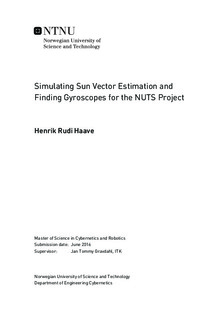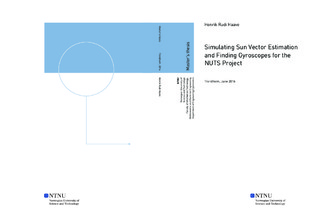| dc.description.abstract | The attitude estimation and control system is completely dependent on sensor input to perform its task of finding the satellites orientation and rotation rate. The three types of sensors need to complete such a task with sufficient accuracy to point the satellite, is assumed to be a Gyroscope for measurement of rotation rate. A Sun sensor for measurement of the first reference vector, and a Magnetometer providing the last reference vector needed for a full orientation estimate. Large uncertainties where present in regards to the accuracy of the Sun sensor prototype consisting of 6 photodiodes mounted on each side of the satellite. The accuracy problem stems from the known fact that reflected light from Earth often gives large errors on the measured Sun vector. Also this prototype of the Sun sensor has no redundancy a problem that absolutely needed to be alleviated. Because of this the following work has been done on the Sun sensor.
\begin{compItemize}
\item \textbf{Simulation} of Sun irradiance and Earth irradiance incident on a satelite in Earth orbit
\item \textbf{A improvement} to the Sun sensor prototype has been suggested and simulated with Sun irradiance and Earth irradiance as the only error source. It is shown that the new configuration of photodiodes allows for both redundancy and limiting of field of view(FOV). Alternative photodiodes have been reviewed and two new photodiodes has been sugested and are expected to improve measurements significantly.
\item \textbf{Two new Sun vector estimation} algorithms have been suggested for the new configuration of photodiodes. They use the FOV limits physically applied to the photodiodes and the redundant design, improving mean error peaks to bellow $5 [deg]$ for the majority of Sun lit orbit time
\end{compItemize}
It was discovered in past work that the attitude controller was very sensitive to error in the rotation rate. Significant work was therefor completed with regards to the choice of a new gyroscope.
\begin{compItemize}
\item \textbf{Microelectromechanical} systems(MEMS) Gyroscope possible Error sources and models where thoroughly investigated and it was found that datasheets where wholly unreliable for choosing a final gyroscope to the NUTS Cube Satellite. The issue of finding a off-the-shelf gyroscope with both good noise characteristics and bias stability with respect to temperature variations was discovered.
\item \textbf{Three Gyroscopes} are suggested for further investigation to find out if they are sufficiently good to make the attitude controller work. These gyrocsopes where chosen from a larger sett putt together from all relevant manufacturers of gyroscopes found.
\end{compItemize} | |

